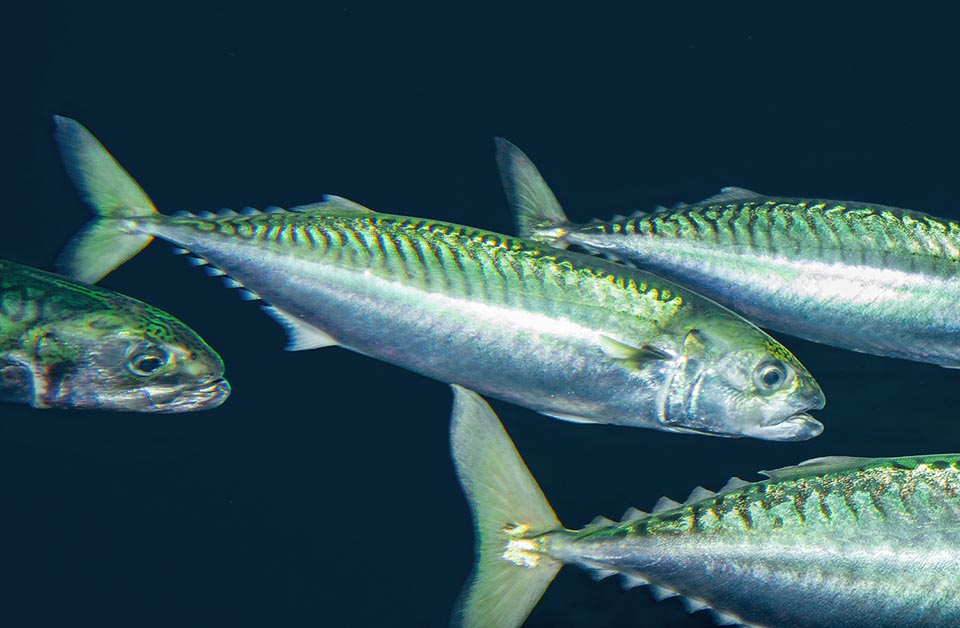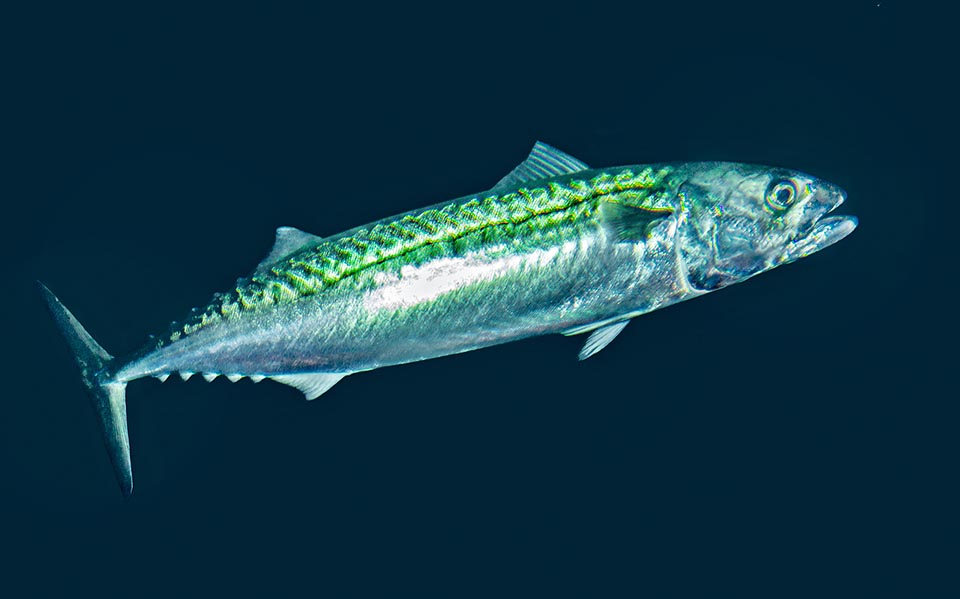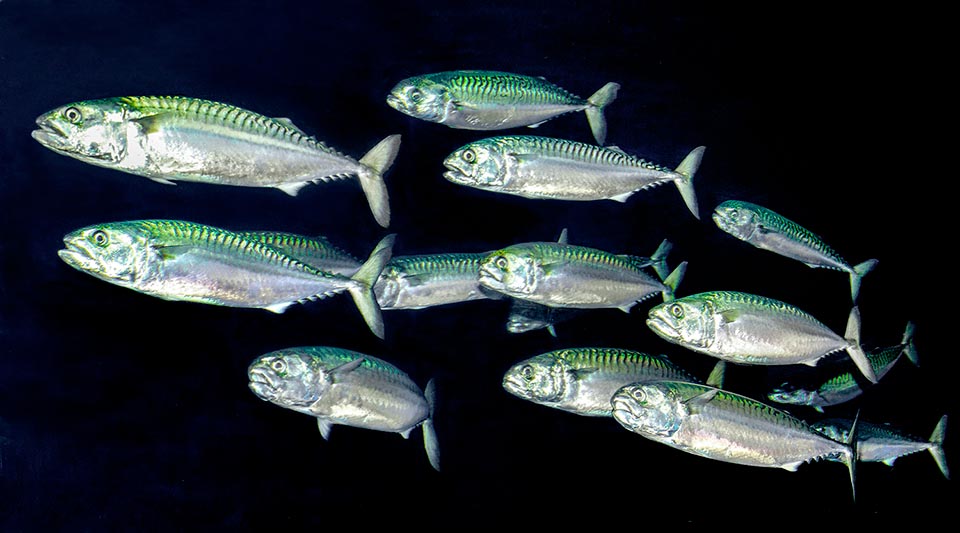Family : Scombridae

Text © Giuseppe Mazza

English translation by Mario Beltramini

Mackerel (Scomber scombrus) is present in dense schools, demersal or pelagic, depending on the season, in North Atlantic, Mediterranean and Black Sea © Giuseppe Mazza
The Mackerel (Scomber scombrus Linnaeus, 1758) belongs to the class of the Actinopterygii, the ray-finned fishes, to the order of the Perciformes and to the family of the Scombridae, counting 15 genera and 54 species, tropical and subtropical, of marine and brackish waters. These fishes are fast predators, at times of big size, like the Bluefin (Thunnus thynnus), that easily exceeds the 3 m of length, but also of relatively modest sized species, such as the Mackerels.
The genus Scomber and the specific term scombrus are, in Latin, the common names, respectively, “scomber”, in Latin, and “σκόμβρος” in Greek (scombros) of this fish, purposedly chosen by Linnaeus in order to point out the great popularity of this fish.
Zoogeography
Tha Mackerel is present in the North Atlantic, from Morocco to Norway, and along the American coasts from USA to Canada. Frequent also in the Maditerranean and in the Black Sea, it is very fished in the Channel and in the North Sea.
Ecology-Habitat
It is a gregarious fish swimming tirelessly in larke schools, between the surface and the 200-250 m of depth. In fact, it cannot stay motionless, as, having no swim bladder, it would sink down if staying without moving. Therefore, obviously, it is an excellent swimmer able to move slowly, with a low energy consumption, but, when needed, to reach the speed of 10 km/h.
During the winter, it is demersal, which means that it lives not far from the bottom. In February, when the water begins to get warmer, it rises to the surface and becomes plegic to reh the sites suitable for the reproduction where every year converge, between March and July, several schools for the group weddings.

It has two dorsal fins. The first, erect, folds when swimming in its own lodging. It eats mainly planktonic crustaceans and small fishes © Giuseppe Mazza
Morphophysiology
Scomber scombrus may reach the length of 60 cm and the weight of 3,4 kg, but the catch is usually measuring 30-40 cm. The body is tapered with pointed head and two well spaced dorsal fins. The first, with 8-14 spiny rays erect in a defensive position, has its own lodging where to fold thus not hindering the swim; the second one, smaller, has 11-13 soft rays. The pectoral fins, triangular, have 18-21 unarmed rays and the pelvic ones, pointed, have 1 spiny ray and 5 soft. The caudal fin is forked as befitting to the fast swimming fishes, preceded on the back and ventrally, by 5 feathery pinnulae.
There is not any evident social dimorphism. The livery presents a characteristic greenish back with metallic reflections striped with 23-332 sinuous transversal black traits, whilst the belly and the sides are silvery.
Ethology-Reproductive Biology
The Mackerel nourishes mainly of pelagic crustaceans it seizes while swimming, mouth open, filtering the water, with the long gill rakes, but the adults swallow also small fishes, in particular the young of the sardines and the anchovies they cross in schools during their wandering.
The reproductive gatherings occur up to 80-120 m of depth when the water is at 12-13 °C. The mature ovary of a female contains 360.000-450.000 eggs, and by each deposition it releases 40.000-50.000 of them. They measure 1-1,38 mm and contain one oil droplet of 0,3-0,4 mm that carries them floating to the surface while they are fecundated by the numerous present males.

Having no swim bladder, must swim ceaselessly for not sinking. The schools gather each year somewhere for group weddings © Giuseppe Mazza
The eggs are pelagic and hatch after 5 days. The larvae move then in more sheltered zones, towards the coasts, where they grow nourishing mainly of copepods.
When one year old, the young measure already 25 cm with a weight of 100 g, but then the growth slows down and for sexual maturity it will be necessary to wait two years more, when they reach the length of 30 cm. The mackerel is a long-lived fish, and if it is not fished or predated, it has a life expectancy of about 20 years. Its natural foes are the tuna and the dolphins, but the decline that takes place in many zones, like in the North Sea, is linked to the industrial fishing with a turnover, just of England, of almost 600 million of Euros.
Animal feed apart, the consumption of the Scomber scombrus is in fact very high. Frequent in the cuisine also due to its low cost, it is rich in vitamins and oméga-3 fatty acids that reduce cardiovascular risks, they strengthen the immune defense and prevent arthritis and Alzheimer’s disease.
Even if there are regulations concerning the minimum size of the catch, from 18 to 30 cm depending on the zones, in order to give this fish the time for growing and reproducing, in some locations the species shows nowadays, in 2020, some decline. The resilience is decent, with a possible doubling of the population in 1,4-4,4 years, but the vulnerability index of the species marks already 44 on a scale of 100.
Synonyms
Scomber glauciscus Pallas, 1814; Scomber vernalis Mitchill, 1815; Scomber vulgaris Fleming, 1828; Scomber vulgaris Wood, 1837; Scomber scriptus Couch, 1863.
→ For general information about FISH please click here.
→ For general information about BONY FISH please click here
→ For general information about CARTILAGINOUS FISH please click here.
→ To appreciate the BIODIVERSITY of BONY FISH please click here.
→ To appreciate the BIODIVERSITY of CARTILAGINOUS FISH please click here.
